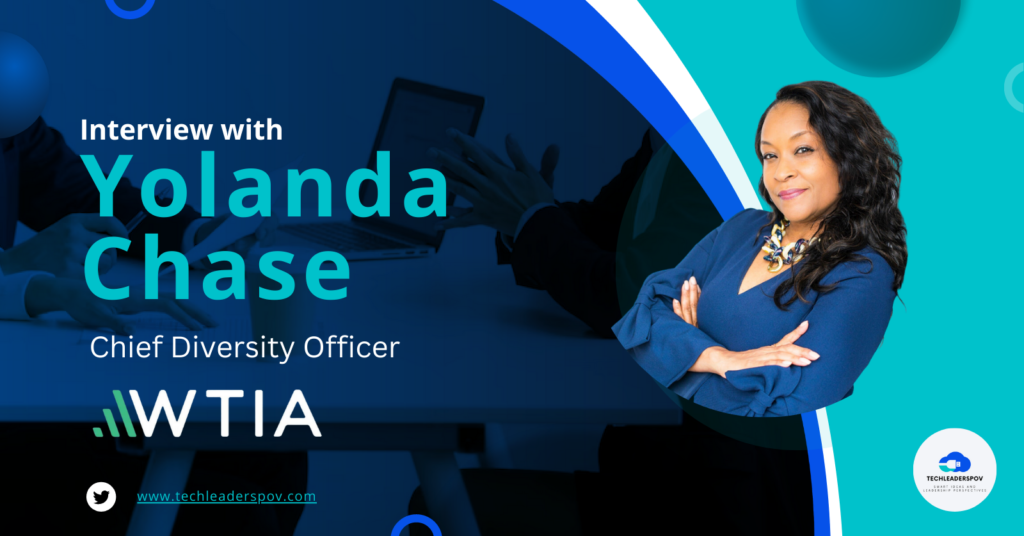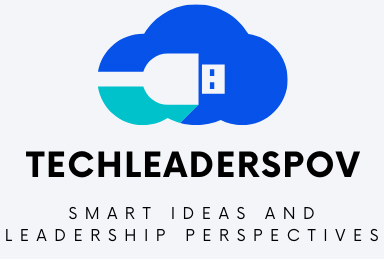As part of our Executive Spotlight Series, TechLeadersPOV spoke with Yolanda Chase, Chief Diversity Officer at Washington Technology Industry Association (WTIA). Yolanda is an expert on DEI strategy and leadership efforts. She is responsible for developing and implementing the organization’s Anti-racism in Tech Pact, which alongside its more than 70 members, aims to dismantle racism in the tech industry.

Can you tell us a story about what brought you to your industry and company? What was behind your desire to start your journey?
My POV derives from my experience as a female who identifies as Black/multi-ethnicity and a leader in the workplace equity and inclusion practice area.
Over the course of my HR career practicing in the areas of diversity, equity and inclusion (DEI), employee experience, and organization development – I’ve spent the bulk of my time working with operations leaders, c-suite leaders and board directors on the strategic creation and implementation of human capital programs. I noticed some consistent themes around how inclusive workplace strategies are adopted or ignored. I also noticed that the dynamic mindset of those groups often dictated how these strategies got adopted, with factors like personality, style, relationship dynamics, familiarity, or comfort with language and topics relative to DEI making the biggest impacts.
This theme had literally haunted me my whole career. One day when I was having a moment of reflection, feeling frustrated about the lack of advancement in workplace equity, I began writing down what I viewed as various roadblocks many leaders face. Where I landed as the root of the issue was far greater than the challenges associated with gaining leadership buy-in for establishing employee resources groups, or setting representation goals that never quite get realized. Real sustainable progress goes beyond anti-racism education and allyship galvanizing that often end up being performative and not a solid commitment to change. The root of the problem is grounded in stalled efforts due to leader knowledge gaps relative to DEI. What was needed was a competency architecture designed for impact. One for the whole company.
What I discovered about myself in this process was an obligation to commit to living from a place of my own personal truths – Developing Diversity Way-Maker™ leadership competency framework came from those 32 years of being frustrated with corporate organizations turning a blind eye to what is really required to achieve sustainable equity and inclusion in their workplaces. Despite the risks, when we do overcome them, the rewards are endless. Starting my own business was powerful because it was birthed through the lens of the diversity I embody, making it much more marketable to the masses.
Can you share the most interesting story that happened to you since you began your career?
My career path was filled with more downs than ups, and those experiences shaped my life and my career. I haven’t done anything else but HR as a true career for 34 years now however, in my younger years, when I was trying to find myself, understand myself, getting to a place of comfort within myself, I always knew deep inside I had this burning “thing” that was telling me that I could do things greater than what I was currently doing. There were some moments in-between where, because of life’s unfortunate events (traumas, abuses), I took odd jobs working at Macy’s and Nordstrom, so that I could feed my babies. I never sat in “I’ve just got to survive” too long. Those experiences shaped my character which led to realizing my greatest potential. I asked myself often “what is going to get me to where I need to be?” I evolved from doing what I had to do in life and in my career to how I delivered the most impactful work I could do. Not just surviving but fulfilling a purpose.
Can you share a story about a mistake you made? Can you tell us what leadership lesson you learned from that experience?
Not fully understanding organizational dynamics and politics in my career or perhaps not even believing that they existed was one of the biggest mistakes I had to come to terms with. For example, trial and error in how you move through an organization, and professional acumen that must be learned and developed. You’re only going to do that by making a lot of mistakes and stepping on a lot of toes. Navigating personalities in power dynamics inside organizations has so many levels associated with them, and it’s often a very unforgiving growth experience, particularly for an opinionated Black woman. The biggest mistake was underestimating just how punitive and unforgiving the working environment can be, especially as you move up in the leadership ranks. Sometimes saying the right thing in the wrong room can be career-ending. I can acknowledge that some of the right things I’ve said in the wrong rooms were perceived as not-so-favorable character indicators. Fortunately, I was able to recover from stereotypes by reflecting on what about that situation could I have done differently, and, how the organizational culture should change to embrace dissenting voices who challenge unhealthy norms.
Do you have any words of leadership advice for others about building their business?
One of the most interesting moments in my career was when I was having a conversation with a very senior female leader in the organization about challenges, my work, and some of my outcomes. I mentioned to her my development goals. She chuckled as she reflected on a conversation between her and the CEO where he made the comment “…why does everyone (employees) want to be more than what they are?” In other words, why do people want to advance in their roles? “Why can’t they just be satisfied in the role that they’re in? Not everyone can be great.” If you take a moment to think about this comment, it explains a lot about why we have a suppressive mindset inside organizations and within our society. We want people to stay “in their place” never grow, never experience greatness because being great isn’t for everyone. And perhaps greatness is preserved for the dominant culture. Examples like this, for me, are huge indicators of what my business can address.
My advice is to keep a close eye on new trends while at the same time anticipating future needs – what you experience informs your greatest product. We’re often told not to get too far ahead of ourselves when conceptualizing market needs and entry. In my opinion, trends give us an idea of what will be needed in the future – anticipating those needs keeps ideas fresh and opens an opportunity to enter the market early, but you must be armed with a clear understanding of whether your product or service is recession proof or can withstand the ups and downs of the economy.
Can you describe the impact technology is making on your industry?
Technology will make a huge impact on how WTIA and Diversity Way-Maker™ teach organizations to disrupt inequity through leadership competency attainment and business integration. Everyone is moving quickly, they want a solution they can key into, a system-ready capability whereby leaders and decision-makers are supported and coached through the most difficult DEI (Diversity Equity, and Inclusion) culture dilemmas. As we build, we’ll leverage the most innovative technology to advance equity and inclusion through accelerated learning. Our goal is to immerse learners in environments that require them to think critically, draw from learned competencies, then leverage the resources inside the environment to solutions, collaborate with others, test/practice, and build strategies and structures that they can lift/shift into their company.
I’ve seen some progressive tech innovation in my field, including a tool that isolates gender equity biases within your organization then correlates economic strength when women are highly represented called Pipeline™, to recruitment software like Included.ai a talent analytics software that connects companies to diverse top talent pools.
What are your “3 takeaways or tips” you can share with our readers about your solution or point of view on building a business or dealing with a changing market?
There are risks associated with going off on your own, most are associated with financial stability while ramping up and scaling the business. This is the greatest risk given the lack of access to capital. Of the 12.3 million women-owned businesses, women-led startups within that group received only 2.3% of venture capital funding in 2020. By the end of 2022, that number has increased to 7%, yet less than 2% represent female founders of Black, Hispanic, or indigenous populations (Fundera). For these founders, starting your own business is riskier and more challenging because of the double-whammy of race/ethnicity and gender bias which sometimes feels insurmountable, especially in the tech sector.
I’ve learned that 1) relationships are indeed key, 2) faith and stamina are required, and 3) tenacity is essential – but most of all, believe in yourself and defy the statistics. Be willing to modify your product and approach based on ever-changing market consumption. Over the years I made mistakes like underestimating or overestimating service costs (what is access to me and my concept worth?) – who is my true customer. Although the challenges are ongoing, I’ve managed to quickly recover from mistakes by living these four points.
Continue Reading…
- Tech CEO Hearing Puts Focus on Kids Safety Bill
- High Costs of AI Keeps Humans at Work, say MIT
- CES 2024: AI in Focus
- VCs Fuel Mining Startups Amid Electric Vehicle Surge
- Redefining ESG Investing with Physis Investment
